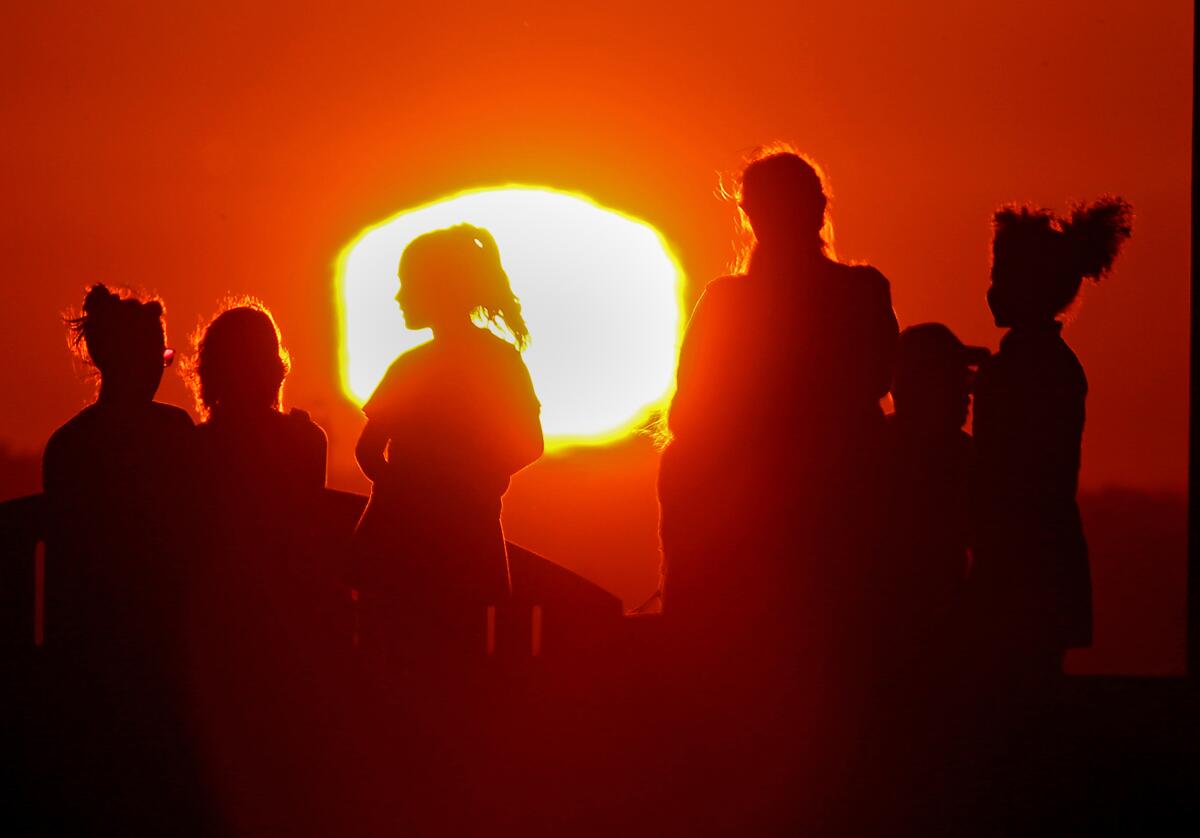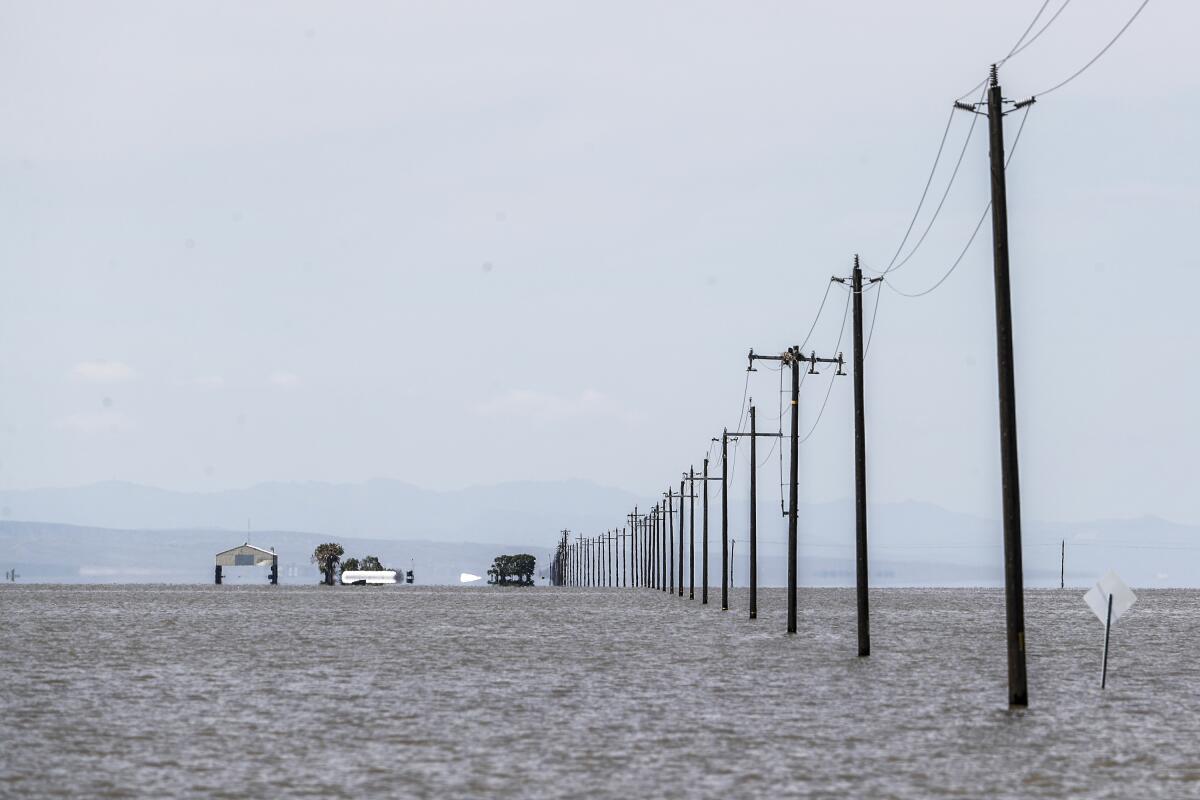A heat dome is on tap for the West. Here’s what to know

- Share via
Good morning. It’s Monday, June 3. Here’s what you need to know to start your day.
- A heat dome is heading for California.
- California has underestimated the epic potential of flooding, according to new research.
- Skip the trendy juice bars and check out this South L.A. gem.
- And here’s today’s e-newspaper.
You're reading the Essential California newsletter
Our reporters guide you through our biggest news, features and recommendations every morning
You may occasionally receive promotional content from the Los Angeles Times.
What to know about the West’s impending heat wave
It’s been a mild to cool spring for much of California, but parts of the state are set to get an early dose of summery temperatures.
Forecasters say a heat dome will bring higher-than-usual temperatures to the Golden State by midweek.
Higher temperatures could stick around California for up to 14 days. The heat dome, which could produce life-threatening conditions in some regions, is also expected to reach the Pacific Northwest and southwestern Canada.
That lingering heat “could break records, prime the landscape for wildfires and kick off a sizzling summer,” L.A. Times environment reporter Hayley Smith writes.
“Though California has enjoyed two relatively tame fire seasons thanks to back-to-back wet winters,” she reported, “it has seen an explosion of new vegetation that can be cured by the incoming heat, creating fuel for future flames.”
How hot is it expected to get — and where?
Portions of Northern California and the Sierra Nevada foothills are expected to bear the brunt, according to UCLA climate scientist Daniel Swain.
Large parts of the Sacramento Valley could experience triple-digit temperatures, with some areas exceeding 110 degrees by midweek. The Central Valley is under an excessive heat watch.
“This will be another event where a fair chunk of California’s population — the near-coastal dwellers in the Bay Area and in Southern California — probably won’t see extreme heat,” Swain said during a media briefing last week. “But you might not have to go that far inland to see dramatically hotter temperatures. And if you go far enough inland, you might even see record-breaking heat.”
Forecasters note that this may be a teaser for a long, sweltering summer.
NOAA’s latest seasonal temperature outlook points to above-normal temperatures in June, July and August across most of the U.S.
It’s not just standard summer heat
Yes, the mercury rises in summertime. But experts note that hotter-than-normal conditions expected over the next few months are being driven by two key factors: changes in the El Niño-La Niña cycle and climate change.
The Pacific climate pattern El Niño has weakened but continues to warm tropical waters, which drive heat waves and other atmospheric patterns.
But El Niño cycles are occurring on a warming globe, courtesy of our continued burning of fossil fuels, which is making heat waves more frequent, prolonged and lethal.
Hayley wrote a detailed explainer on how climate change is affecting heat waves in the Golden State and beyond — and what we can expect if current emissions continue unabated.
“Although California and the American West will continue to experience cool days and periods of heavy snowpack, scientists say the long-term trend is for the planet to grow hotter with the continued burning of fossil fuels,” she wrote. “Since 1880, the global average temperature has increased by about 2 degrees.”
More intense heat waves, more deaths
The potential for record-breaking and sustained summer heat exposes millions to heat-related illnesses and death.
An analysis by the Associated Press found that last year’s summer heat killed more than 2,300 people in the U.S., a record. That figure is likely a major undercount, dozens of experts told AP reporters. Heat kills more people each year than hurricanes, floods and wildfires.
A heat wave in 2022 killed an estimated 395 people in California, according to state health officials.
Extreme heat disproportionately affects children and the elderly, people with chronic illnesses, disabled people and those who are pregnant. It also has a greater impact on people who work predominantly outdoors, such as construction workers, landscapers and agricultural workers.
California has struggled to keep up with the dangers of extreme heat, which is intensifying due to human-caused climate change. Gov. Gavin Newsom launched the Extreme Heat Action Plan in 2022, which states that a proper response to the hazards posed by deadly heat “will require time, effort and funding.”
But state leaders plan to slash funding for the Extreme Heat and Community Resilience Program by more than 60%. According to a state Assembly committee summary from May, the program would lose $110.1 million of its $175-million allotment.
Today’s top stories

Climate and environment:
- As Los Angeles plans to take less water, environmentalists celebrate a win for Mono Lake.
- The U.S. Drought Monitor is a critical tool for the arid West. But can it keep up with climate change?
- Wildfire scorches more than 12,500 acres, prompting evacuations in the Central Valley.
Policing and criminal justice:
- Who should be the next LAPD chief? Angelenos shrug as the city asks for public input.
- For some incarcerated women, getting ahold of menstrual products is a nightmare.
Mexico presidential election:
- Hundreds of voters cast ballots at the Mexican Consulate in Los Angeles in a historic presidential election.
- Mexico elects leftist Claudia Sheinbaum as the first female president in its history.
More big stories:
- WeHo Pride parade-goers talk joy and inclusivity, trans rights and a thread of fear.
- Caltrans’ infrequent and subpar inspections allowed for the conditions that caused a massive fire that shut down the 10 Freeway in downtown L.A. last year, the agency’s inspector general has found.
- After 13 years, a homeless Angeleno broke into her old, vacant home and wants to stay forever.
- Elon Musk, America’s richest immigrant, is angry about immigration. Can he influence the election?
- A Santa Monica sci-fi museum controversy centers on a child porn conviction, delays and angry “Star Trek” fans.
- A Monaco billionaire has struck a deal to grant public access to a Big Sur property with breathtaking views.
Get unlimited access to the Los Angeles Times. Subscribe here.
Commentary and opinions
- George Skelton: Newsom has finally gotten moving on fixing California’s homeowner insurance crisis.
- Times editorial board: Californians don’t have to accept skyrocketing electric bills. Here’s how to fight back.
- Jackie Calmes: The Supreme Court’s all-important Jan. 6 decisions will be tainted.
- Times editorial board: Mayor Bass has no more excuses for delaying Venice Dell homeless housing.
- Guest opinion: Was my favorite teacher gay? I thought maybe a belly dancer could find out.
Today’s great reads

California has underestimated the epic potential of future flooding, research shows. Looks like our “Great Flood” wasn’t actually our most devastating. Researchers found evidence of two epic Southern California floods that occurred in the last 600 years and were much larger than the Great Flood of 1862.
Another great read:
- They cut their water bill by 90% and still have a “showstopping” L.A. garden.
How can we make this newsletter more useful? Send comments to [email protected].
For your downtime

Going out
- 🥒 Forget the trendy juice bars. This is the place to go for green juice.
- 🖼️ Explore timely museum shows by Mickalene Thomas and Simone Leigh at the Broad and California African American Museum, respectively (and read Christopher Knight’s review).
Staying in
- 🏳️🌈 Here are 13 essential LGBTQ+ television shows (plus a parade) to watch during Pride Month.
- 🧑🍳 Here’s a recipe for sheet pan sausages with cherry tomatoes and onions.
- ✏️ Get our free daily crossword puzzle, sudoku, word search and arcade games.
And finally ... a great photo
Show us your favorite place in California! We’re running low on submissions. Send us photos that scream California and we may feature them in an edition of Essential California.

Today’s great photo is from Los Angeles resident Robert Gideon: the L.A. staple that is Union Station.
Robert writes: “The awe-inspiring vaulted ceilings, marble and old wood framing in the original ticketing area ... speak to another era of grandeur that is representative of Downtown L.A.’s historic early 20th century period. The historic ticket counters in the background have long since been replaced, but the information desk is still very active.”
Have a great day, from the Essential California team
Ryan Fonseca, reporter
Amy Hubbard, deputy editor, Fast Break
Check our top stories, topics and the latest articles on latimes.com.
Sign up for Essential California
The most important California stories and recommendations in your inbox every morning.
You may occasionally receive promotional content from the Los Angeles Times.




